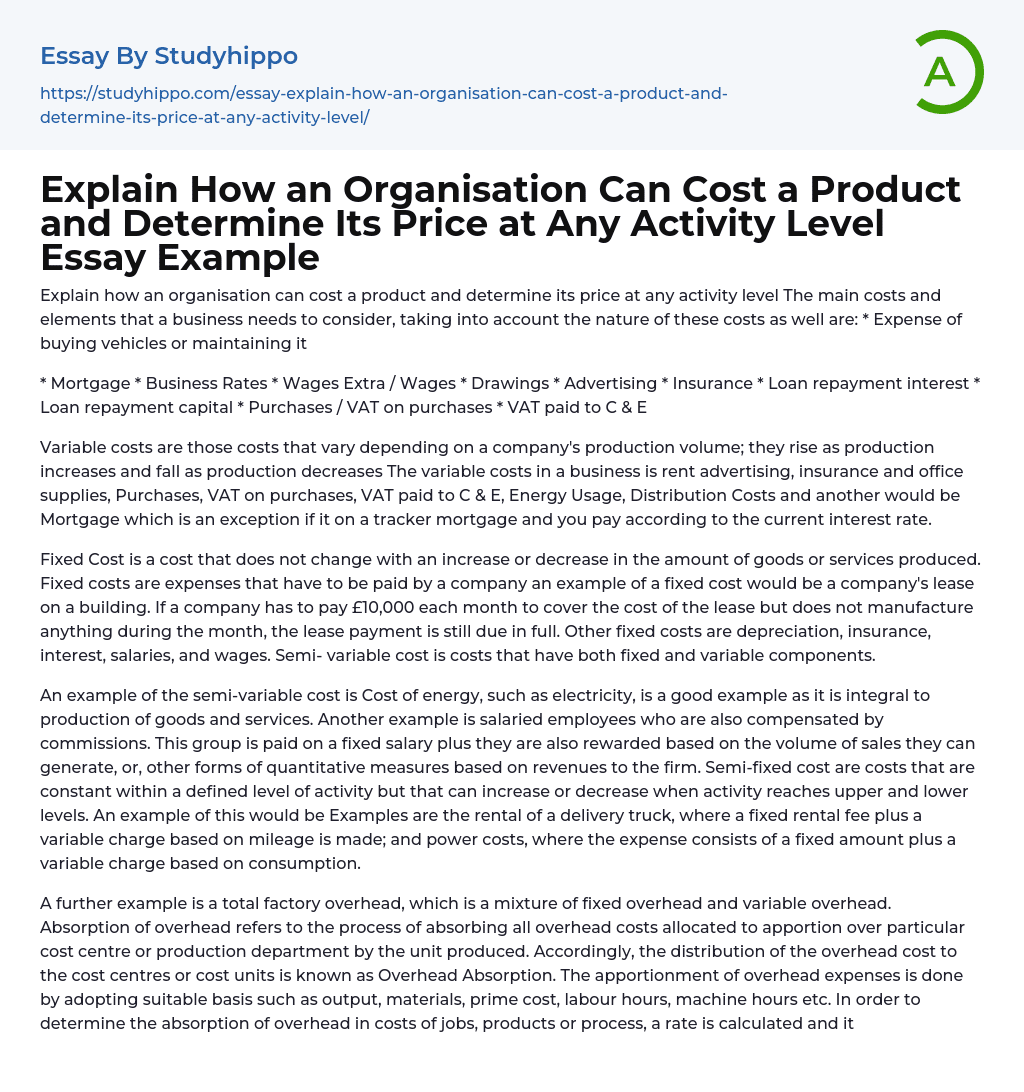The following article focuses on the process of costing and pricing a product for organizations, regardless of their activity level. It highlights the significance of taking into account different costs, such as vehicle purchasing or maintenance expenses, while considering their specific characteristics.The following expenses are deducted from the gross income: Mortgage, Business Rates, Wages Extra / Wages, Drawings, Advertising, Insurance, Loan repayment interest, Loan repayment capital, Purchases / VAT on purchases, and VAT paid to C & E.
The costs that vary with a business's production volume include rent, advertising, insurance, office supplies, purchases, VAT on purchases, VAT paid to C ; E, energy usage, and distribution costs. These costs increase as production increases and decrease as production decreases. However, mortgage payments are an exception to variable costs because they depend on the current interes
...t rate if it is a tracker mortgage.
A fixed cost is an expense that remains constant regardless of the quantity of goods or services produced. Examples of fixed costs include a company's building lease, which must be paid even if no manufacturing occurs. Other examples are depreciation, insurance, interest, salaries, and wages. In contrast, semi-variable costs have both fixed and variable components.
The cost of energy, such as electricity, is an example of a semi-variable cost that is crucial for the production of goods and services. Another example is salaried employees who receive both a fixed salary and commissions tied to their sales performance or other quantitative measures related to the company's revenue. Semi-fixed costs remain constant at a certain level of activity but can change when activity exceeds specific thresholds. Examples include renting a delivery truck
which has a fixed rental fee in addition to a variable charge based on mileage, and power costs, which consist of a fixed amount along with a variable charge based on consumption.
A total factory overhead is a combination of fixed overhead and variable overhead. Overhead absorption refers to the process of allocating all overhead costs to specific cost centers or production departments based on the units produced. This process, known as overhead absorption, involves distributing the overhead cost to cost centers or units using appropriate factors such as output, materials, prime cost, labor hours, machine hours, etc. To determine the absorption of overhead in the costs of jobs, products, or processes, an overhead absorption rate is calculated.
The idea of marginal cost pertains to the alteration in costs due to a modification in output. It specifically denotes the fluctuation in total cost when the quantity produced is altered by one unit. For example, while constructing a new factory, the marginal cost encompasses the expense of building said factory. In terms of pricing strategies, businesses possess multiple choices. One method involves establishing the price of a product or service by taking into account the production cost and adding the desired profit margin. Alternatively, businesses can determine prices based on their competitors' charges.
- Money essays
- Financial Accounting essays
- Market Segmentation essays
- Supply And Demand essays
- Purchasing essays
- Forecasting essays
- Legacy essays
- Bank essays
- Corporate Finance essays
- Financial News essays
- Financial Ratios essays
- Financial Services essays
- Free Market essays
- Shareholder essays
- Personal finance essays
- Equity essays
- Financial Crisis essays
- Banking essays
- Credit Card essays
- Currency essays
- Debt essays
- Gold essays
- Loan essays
- Enron Scandal essays
- Foreign Exchange Market essays
- Investment essays
- Venture Capital essays
- Stock Market essays
- Retirement essays
- Donation essays
- Net Present Value essays
- Income Statement essays
- Commercial Bank essays
- Debit Card essays
- Deposit Account essays
- Subprime Lending essays
- Perfect Competition essays
- Underwriting essays
- Synergy essays
- Valuation essays
- Investing essays
- Asset essays
- Depreciation essays
- Discounted Cash Flow essays
- Foreign Direct Investment essays
- Funds essays
- Internal Rate Of Return essays
- Revenue essays
- Day Trading essays
- Futures Trading essays




